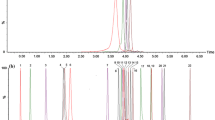Abstract
Anthocyanins are considered the principal agent for wine’s intense color response for the first sensory sight assessed by the consumers, the appearance. Most grapes produce five different anthocyanin classes, each presenting different chromatic attributes and oxygen predispositions since they present two phenolic rings and one heterocyclic pirano ring, determining high chemical instability. Red wines maintain their intense red color with high stability due to reactions that occur between anthocyanins (self-association), copigments, polymerization with other flavonoids, and synthesis of pyranoanthocyanins. Wines produced from Vitis vinifera grapes produce anthocyanin monoglucosides, and wines produced with non-Vitis vinifera or hybrid grapes produce mono- and diglucosidic anthocyanins. Monoglucosidic anthocyanins guarantee higher color intensity; however, diglucosidic anthocyanins provide higher chemical stability. This chapter covers analytical methods of anthocyanin identification and quantitation using spectrophotometric and high-performance liquid chromatography coupled to a diode array detector in tandem with electrospray ionization mass spectrometry (HPLC-DAD-ESI-MS/MS).
Access this chapter
Tax calculation will be finalised at checkout
Purchases are for personal use only
Similar content being viewed by others
References
Jackson RS (2020) Wine science: principles and applications. Academic Press, San Diego
De Castilhos MBM, Del Bianchi VL (2021) Vinhos. In: Moraes IO (ed) Biotecnologia Industrial: Biotecnologia na Produção de Alimentos. Blucher, São Paulo
Versari A, Boulton RB, Parpinello GP (2008) A comparison of analytical methods for measuring the color components of red wines. Food Chem 106:397–402
Božič JT, Butinar L, Albreht A, Vovk I, Korte D, Vodopivec BM (2020) The impact of saccharomyces and non-saccharomyces yeasts on wine colour: a laboratory study of vinylphenolic pyranoathocyanin formation and anthocyanin cell wall adsorption. LWT 123:109072
Cebrián-Tarancón C, Fernández-Roldán F, Sánchez-Gómez R, Alonso GL, Salinas MR (2022) Pruned vine-shoots as a new enological additive to differentiate the chemical profile in wines. Food Res Int 156:111195
Diblan S, Özkan M (2021) Effect of various clarification treatments on anthocyanins, color, phenolics and antioxidant activity of red grape juice. Food Chem 352:129321
Ju Y, Yang L, Yue X, Li Y, He R, Deng S, Yang X, Fang Y (2021) Anthocyanin profiles and color properties of red wines made from Vitis davidii and Vitis vinifera grapes. Food Sci Hum Wellness 10(3):335–344
De Castilhos MBM, Del Bianchi VL, Gómez Alonso S, García-Romero E, Hermosín-Gutiérrez I (2019) Sensory descriptive and comprehensive GC-MS as suitable tools to characterize the effects of alternative winemaking procedures on wine aroma. Part I: BRS Carmem and BRS Violeta. Food Chem 272:462–470
De Castilhos MBM, Corrêa OLS, Zanus MC, Garcia Maia JD, Gómez-Alonso S, García-Romero E, Del Bianchi VL, Hermosín-Gutiérrez I (2015) Pre-drying and submerged cap winemaking: effects on polyphenolic compounds and sensory descriptors. Part II: BRS Carmem and Bordô (Vitis labrusca L.). Food Res Int 76:697–708
Acevedo A, Hilbert G, Rivière C, Mengin V, Ollat N, Bordenave L et al (2012) Anthocyanin identification and composition of wild Vitis spp. accessions by LC-MS and LC-NMR. Anal Chim Acta 732:145–152
Zhu L, Zhang Y, Deng J, Li H, Lu J (2012) Phenolic concentrations and antioxidant properties of wines made from North American grapes grown in China. Molecules 17:3304–3323
Robinson WB, Weirs LD, Bertino JJ, Mattick LR (1966) The relation of anthocyanin composition to color stability of New York state wines. Am J Enol Vitic 17:178–184
Ribéreau-Gayon P, Glories Y, Maujean A, Dubourdieu D (2006) Handbook of enology: the chemistry of wine – stabilization and treatments. Wiley, New York
Ribéreau-Gayon P, Stonestreet E (1965) Determination of anthocyanins in red wine. Bull Soc Chim Fr 9:2649–2652
Castillo-Muñoz N, Fernández-González M, Gómez-Alonso S, García-Romero E, Hermosín-Gutiérrez I (2009) Red-color related phenolic composition of Garnacha Tintonera (Vitis vinifera L.) grapes and red wines. J Agric Food Chem 57:7883–7891
Pérez-Navarro J, Izquierdo-Cañas PM, Mena-Morales A et al (2019) Phenolic compounds profile of different berry parts from novel Vitis vinifera L. red grape genotypes and Tempranillo using HPLC-DAD-ESI-MS/MS: a varietal differentiation tool. Food Chem 295:350–360
Author information
Authors and Affiliations
Corresponding author
Editor information
Editors and Affiliations
Rights and permissions
Copyright information
© 2023 The Author(s), under exclusive license to Springer Science+Business Media, LLC, part of Springer Nature
About this chapter
Cite this chapter
de Castilhos, M.B.M., Gómez-Alonso, S., García-Romero, E. (2023). Anthocyanin Identification and Quantitation by High Performance Liquid Chromatography Coupled with Mass Spectrometry (HPLC-MSn). In: Machado de Castilhos, M.B. (eds) Basic Protocols in Enology and Winemaking. Methods and Protocols in Food Science . Humana, New York, NY. https://doi.org/10.1007/978-1-0716-3088-4_6
Download citation
DOI: https://doi.org/10.1007/978-1-0716-3088-4_6
Published:
Publisher Name: Humana, New York, NY
Print ISBN: 978-1-0716-3087-7
Online ISBN: 978-1-0716-3088-4
eBook Packages: Springer Protocols




